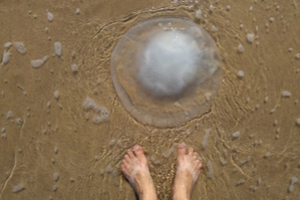Treating Jellyfish Stings

Summer is the season for vacation, a time when families and friends gather along the seashore to enjoy water play and make memories together. It is also the season when jellyfish abound in the temperate waters of the coast. This year there have been numerous reports of jelly fish stings, and of course South Florida is no exception. When jellyfish stings happen, most people, especially those who are vacationing at the beach, don’t know how to treat the sting and remedy the situation quickly.
The Low Down on Jellyfish
Jellyfish are among the earth’s oldest creatures, pre-dating the dinosaurs, and having survived for millions of years. They float along with the oceans’ currents in all water temperatures and a variety of depths. Their name is a misnomer, as the jellyfish are not fish at all, but invertebrates. Jellyfish come in a variety of colors including pink, yellow, purple, and blue, others are clear, and some are luminescent. Jellyfish have tentacles equipped with stingers which are used to paralyze their prey (fish, crabs, shrimp) before eating them.
Jellyfish Stings
Jellyfish don’t attack people, quite the contrary, stings most often occur when people bump into jellyfish accidentally. When this happens, the jellyfish inject their venom into the person who bumped them. The result – pain, red blisters, and the potential for life-threatening allergic reactions. Knowing how to react and treat jellyfish stings will keep you and your family safe at the beach and your vacation on track.
Care and Treatment of a Jellyfish Sting
Knowing what to do can make all the difference when you, your friend, or family member suffers a jellyfish sting.
The first step is to get the person out of the water. Next find the sting location. If you see signs of an allergic reaction or a sting that covers a large area on the body, call 911 immediately or take the person to nearest medical facility so he or she can get the needed treatment as quickly as possible.
When the sting is mild, with no allergic reaction, you should be able to treat the sting successfully with these steps. Remove any tentacles which are attached to the skin carefully using a plastic object. If no such object is available, use ocean water to neutralize the tentacle’s stingers.
If you can identify the type of jellyfish, special steps should be taken. For example, the sting of a box jellyfish requires professional medical attention, so the anti-venom can be administered quickly.
If the jellyfish can’t be identified and appears to be mild, proceed with the following steps. Taking the pain away is paramount for the victim. An application of over-the-counter hydrocortisone should relieve pain along with any itching or swelling. An oral antihistamine can also help in the recovery. Ice packs applied to the sting area often help to reduce pain as do over-the-counter pain medications.
Now that the victim’s pain has been addressed, to promote healing you should clean the area three times daily, applying antibiotic ointment and bandages as needed.
Should any issues arise during recovery, take the sting victim to the nearest physician, urgent care facility, or emergency room for further evaluation. These medical professionals are ready to help with jellyfish stings and get your vacation fun in the sun back on track as quickly as possible.
